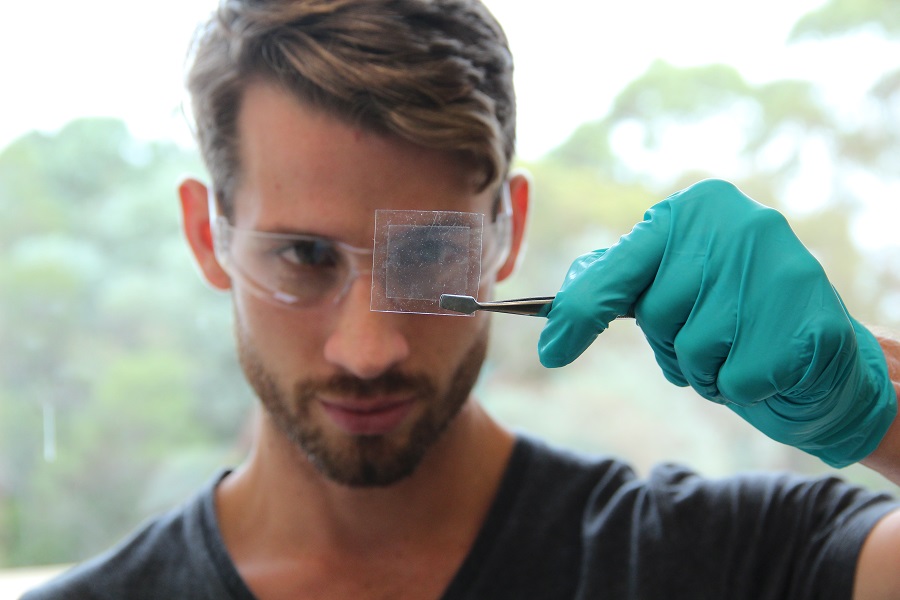Our scientists have created a new way to produce the world's strongest material.

A scientist looking at graphene
Real superheroes use graphene.
Graphene is, quite literally, the stuff of superhero comics. It’s made from carbon, is one atom thick, has an optical transparency of 97.3% and also happens to be the strongest material on earth. No wonder it’s already featured as Tony Stark’s new, bulletproof and transparent face-plate in Marvel Comics’ Superior Ironman #2.
Apart from a superhero’s armour, graphene is actually very useful in real life. It can do anything from improving battery performance in energy devices to developing water purification membranes. We’ve known its potential for a long time, but the major roadblock in commercialising it has always been the high-cost of producing quality, large-scale graphene.
Traditionally, graphene was grown in a highly-controlled environment with explosive compressed gases, long hours of operation at high temperatures (sometimes 1000°C) and extensive vacuum processing.
Until now.
Our origin story begins in Lindfield, New South Wales, where our scientists have found a cheaper and faster way to produce graphene. We’ve said goodbye to expensive processes and discovered a unique, low-cost solution to grow graphene using soybean oil and ambient air.
Alongside The University of Sydney, University of Technology Sydney, and The Queensland University of Technology, we’ve come up with GraphAir technology. The new technology transforms soybean oil – a renewable and natural material – into functional and highly controlled graphene films composed of one to a few layers, all in a single step. The technology reduces the cost of graphene production to a fraction of its current price, making it a whole lot cheaper to produce, while providing many new applications.
Speaking of applications, it has excellent electronic, mechanical, thermal and optical properties. Further uses range from water filtration to renewable energy, sensors and personalised healthcare and medicine, just to name a few.
But we haven’t stopped there. The team has also been testing other triglyceride (carbon)-containing precursors – like butter and even waste oils drained from your barbecue – which can also be used to create graphene.
You heard it right! In the future you could turn your barbecue waste into the strongest material on earth, that also cleans the environment. Talk about a win-win situation!
Now that we’ve figured out low-cost production method for graphene, our now the next step is getting it commercialised ASAP so our smart phones can have better-than-ever battery performance.
You can learn more about our superhero scientists and the amazing work they do here.


11th March 2017 at 11:00 am
Soybeams was used in the second world war by the Japanese replacing plastic on military steering wheels! Strange but True!
9th February 2017 at 9:41 pm
S’all very good n all, BUT can you do it with olive oil. (Grows on trees. Trees are better for the global ecology/climate than soybeans. Besides, soybeans are bastards of things to grow, Olives are very forgiving & versatile). In any case you’ll need to develop better ways of producing Hydrogen gas as the power system of the future (present). Why? Because the whole universe is powered by Hydrogen & if you want to see more of it (& quickly) you’ll need to be involved in getting those systems functional.
3rd May 2017 at 12:28 pm
Correction: soybean is a relatively easy crop to grow and is suited to a wide range of soil types across in eastern and northern Australia. Compared to other annual crops, soybean has basic nutrient requirements and has the added bonus of leaving the soil in better shape (biologically and nitrogen-wise) for the next crop or pasture than almost any other legume. Basic agronomy skills are required to grow any crop well.
29th June 2017 at 3:05 pm
Good to know. Soybeans and olives have different water requirements though. I’m also wondering about the rate of yield of each crop and how they compare – not just kg/ha, but kg/ha/yr? How many soybean crops can be grown in a particular location in a year?
9th February 2017 at 4:58 pm
I have a Graphene deposit 100M ton. Think it should be developed? $12B to $100’sB in Secondary. In 1 for 4 known deposits, in my area. And more elsewhere! 🙂
9th February 2017 at 2:17 pm
It was amazing!
9th February 2017 at 11:21 am
Sounds great, does it break down? What sort of lifespan does it have and can it be re-used/re-cycled?
9th February 2017 at 2:37 pm
Hi Maria,
Graphene is generally very stable under normal conditions where no strong acids or plasma, thus it does not breakdown and has a long lifespan. Depending on how graphene is placed in the device, it may or may not be recycled.
Regards,
Ellen